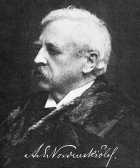 |
A. E. Nordenskiöld and his Collections in Helsinki University LibraryAdolf Erik NordenskiöldAdolf Erik Nordenskiöld was born in Helsinki on 18 November 1832, but spent his early youth on the family estate in Mäntsälä. He went to school in Porvoo, a small town on the South coast of Finland. He studied mathematics, chemistry, mineralogy, and geology and gained his masters degree in 1853 at the Imperial Alexander University in Helsinki, and published two years later his dissertation Om grafitens och chondroditens kristallformer [On the crystal forms of the graphite and chondrodite]. In 1856 he was appointed docent in Mineralogy in Helsinki. For political reasons he, however, had to flee in the following year to Sweden, where he was called to the office of Director of the Mineralogical Department of the Swedish Museum of Natural History and to a professorship in Mineralogy at the Swedish Academy of Sciences. Nordenskiöld died in Dalbyö, Sweden, on 12 August 1901. Nordenskiöld gained world-wide fame as an explorer and as the discoverer of the Northeast Passage. He took part in the expeditions to Svalbard (Spitzbergen) in 1858 and 1861, and led other expeditions to the same region in 1864, 1868 and 1872. To Greenland he travelled in 1870 and 1883. Nordenskiöld investigated the navigability of the Kara Sea in 1875 and 1876. The sailing through the Northeast Passage took place in 1878-1879, and he returned to Stockholm in 1880. The literary production of Nordenskiöld contains 178 titles. The most widely known of them are the account of the voyage Vegas färd kring Asien och Europa [The voyage of the Vega round Asia and Europe], 1-2 (1880-1881), which has been translated to ten different languages, and the great cartographic works Facsimile atlas till kartografiens äldsta historia [Facsimile-atlas to the early history of cartography] (1889), a nd Periplus, utkast till sjökortens och sjöböckernas äldsta historia [Periplus: an essay on the early history of charts and sailing directions] (1897). The Nordenskiöld Collection in Helsinki University LibraryThe University of Helsinki bought A.E. Nordenskiöld´s private collection of geographic literature and maps from Sweden in 1902 and joined it to the collections of the library. Nordenskiöld had during his life uttered the wish that his collection should be placed in Finland and kept as a whole. This collection is one of the most complete of its kind. It is most comprehensive concerning the oldest printed cartographic atlases, geographical works, and travel literature. The collection is especially rich in early history of cartography, printed Ptolemaic atlases, sea atlases and incunabulas. It contains about 5 000 volumes covering the knowledge of the expansion of the known world from the Antiquity to Modern Times. A.E. Nordenskiöld gathered his collection specially to serve as basis for his investigations, but in the aqcuisitions he also considered the bibliophile aspect. Originally his aim was to collect as completely as possible the cartographic and geographical literature prior to 1570, but later he extended his interest to the literature of 17th and 18th centuries. The collection contains 123 incunabulas, 49 different printed Ptolemy editions, and works of several famous geographers and cartographers such as Münster, Olaus Magnus, Apian, Ortelius, Waghenaer, Mercator, Blaeu, van Keulen, Janssonius, and Homann. The maps in Ptolemy´s Geography give a picture of how the Age of Discovery and the growth of knowledge advanced the range of information about new regions and how the picture of the entire world became more detailed on the maps. Nordenskiöld's library of early cartographic literature is unique. The A.E. Nordenskiöld Collection is included in the Memory of the World Register of UNESCO. Translation: Malcolm Hicks. 
|
